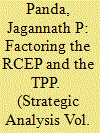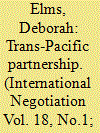|
|
|
Sort Order |
|
|
|
Items / Page
|
|
|
|
|
|
|
| Srl | Item |
| 1 |
ID:
116618


|
|
|
|
|
| Publication |
2012.
|
| Summary/Abstract |
The Trans-Pacific Partnership (TPP) is a multilateral free trade agreement (FTA) which aims to liberalize the economies of the Asia-Pacific region. The rapid movement of the TPP agenda, however, has caused China some disquiet. Originally, the agreement was signed among four countries (Brunei, Chile, New Zealand and Singapore) on June 3, 2005, and entered into force on May 28, 2006. In 2008, five additional countries (Australia, Malaysia, Peru, the United States, and Vietnam) began negotiations to join the group.1 On November 12, 2011, the leaders of these nine TPP partner countries announced the broad outlines of an expanded TPP: it will promote innovation, enhance economic growth and development, and support the creation and retention of jobs among the nine dynamic Asia-Pacific economies.2 Further negotiations are still underway, with Japan, Canada, and Mexico also having demonstrated a strong interest in joining.
|
|
|
|
|
|
|
|
|
|
|
|
|
|
|
|
| 2 |
ID:
127468


|
|
|
|
|
| Publication |
2014.
|
| Summary/Abstract |
The Regional Comprehensive Economic Partnership (RCEP) and the Trans-Pacific Partnership (TPP) are not necessarily two contending trade liberalising models, but their import and arrival have posed stiff political challenges for many countries, including China and India, Asia's two heavyweights. With these two initiatives, the regional trade of Asia is entering an interesting phase of liberalisation and integration. In fact, it is gradually becoming clear that the facets and nuances attached to these two trade liberalisation models will impact regional power politics massively in times to come. While the success of TPP hinges on the global economic authority of the US and how the negotiation process unfolds, the future dynamism of RCEP will depend heavily on how China and the Association of South-East Asian Nations (ASEAN) conduct their negotiation process and accommodate the interests of other regional powers, including India. Hitherto, it has been no secret that both RCEP and TPP will greatly affect and influence ASEAN and the role of its free trade agreement (FTA) partner countries, including China and India. In this regional stratagem, China-India relations may witness new dynamics and power politics in East Asia or in the broader Asia-Pacific region. It may also open a new window of opportunity for India's greater integration with the East Asia region. India needs to analyse carefully the efficacy and implications of both RCEP and TPP to see how far they serve New Delhi's own regional interests. RCEP may eventually facilitate India's 'Look East' policy more effectively than TPP. The former allows New Delhi to coordinate with ASEAN+6 countries more effectively, to which China has so far been fundamentally opposed.
|
|
|
|
|
|
|
|
|
|
|
|
|
|
|
|
| 3 |
ID:
126265


|
|
|
|
|
| Publication |
2014.
|
| Summary/Abstract |
Just over a year ago, as President Enrique Peña Nieto started his administration, the domestic and international press were touting "Mexico's moment" and the rise of "the Aztec tiger." Now, the naysayers have returned. Their pessimism stems in part from disappointing economic results: Mexico's GDP growth has fallen, from nearly four percent in 2012 to around an estimated one percent in 2013. The negativity also reflects the impatience of pundits and markets, as the economic dividends from Peña Nieto's ambitious economic reform agenda have yet to appear.
|
|
|
|
|
|
|
|
|
|
|
|
|
|
|
|
| 4 |
ID:
120716


|
|
|
|
|
| Publication |
2013.
|
| Summary/Abstract |
Abstract Much has been made of the "spaghetti or noodle bowl" problem of overlapping preferential trade agreements (PTA). A new PTA, the Trans-Pacific Partnership (TPP), currently under negotiation between eleven states - Australia, Brunei, Canada, Chile, Malaysia, Mexico, New Zealand, Peru, Singapore, the United States and Vietnam - is intended to help address this issue. The TPP will lower or eliminate barriers to trade among the partners. But officials are not operating in a vacuum as they negotiate this new agreement. Instead, they must contend with rules created in previous agreements, many of which link TPP partners together in ways that constrain their options now. This article looks in detail at negotiations over market access in goods to better understand the tradeoffs faced by negotiators. Unfortunately, some of the decisions made so far after three years of talks suggest that the TPP market access deal could end up being just another twisted noodle in a crowded bowl.
|
|
|
|
|
|
|
|
|
|
|
|
|
|
|
|
|
|
|
|
|